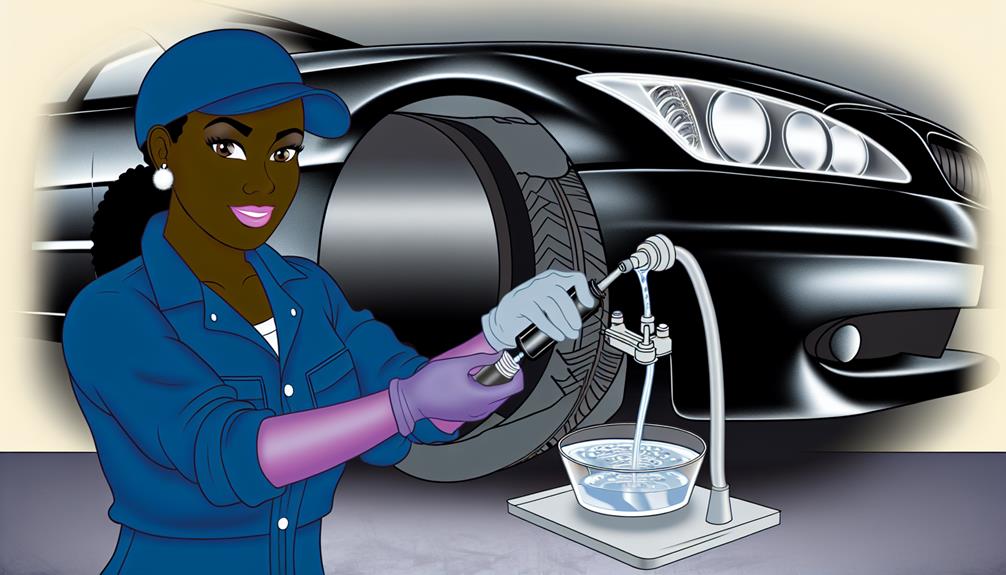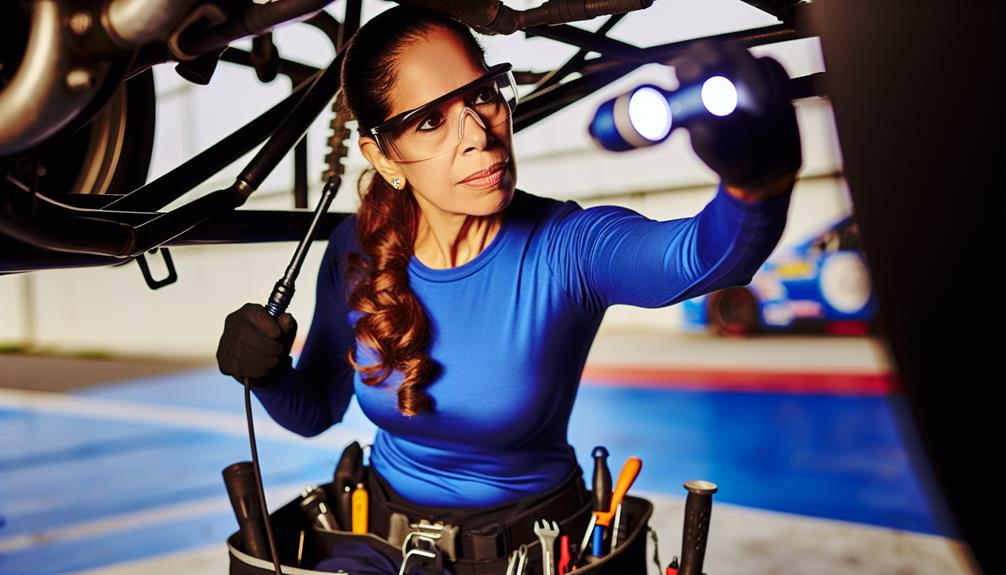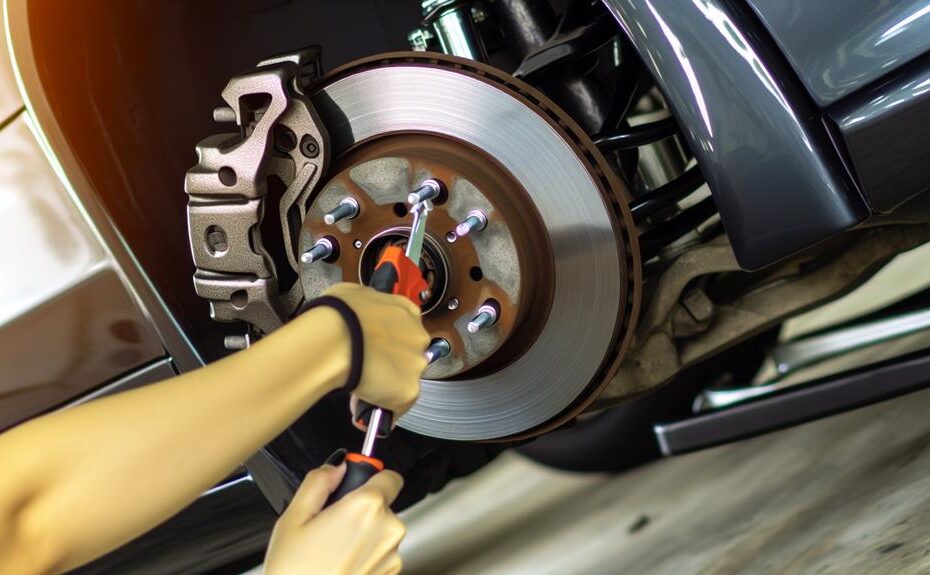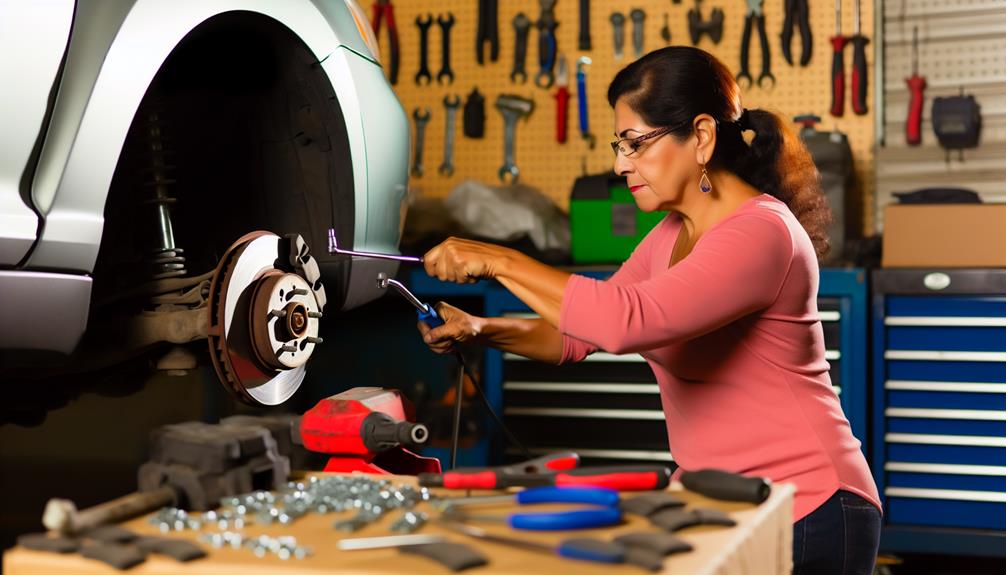When it comes to high-performance cars, the brakes are the unsung heroes, quietly ensuring your safety and control on the road. Like a well-oiled machine, they work tirelessly to bring your speed to a halt, but even the best brakes need some TLC from time to time.
That's why we're here to unveil the top 5 brake repairs that will keep your high-performance car running smoothly and stopping on a dime.
So, buckle up and get ready to discover the secrets behind maintaining the optimal braking power of your high-performance vehicle.
Key Takeaways
- Regular maintenance and replacement of brake pads is crucial for optimal performance in high-performance cars.
- Rotor maintenance and upgrades, such as resurfacing and upgrading, can enhance performance and durability.
- Brake fluid flush every two years is essential to ensure optimal brake performance and prevent brake failure.
- Regular inspection and repair of calipers and brake lines is necessary to maintain optimal braking performance and prevent accidents.
Brake Pad Replacement
When it comes to maintaining the optimal performance of your high-performance car, one crucial aspect to consider is the regular replacement of brake pads. Brake pads play a vital role in the braking system by providing the necessary friction to slow down or stop your vehicle. Over time, the brake pad material wears down, reducing its effectiveness and compromising your safety on the road.
The lifespan of brake pads can vary depending on several factors, including your driving style, road conditions, and the quality of the brake pad materials. On average, brake pads need to be replaced every 30,000 to 70,000 miles. However, it's essential to monitor their condition regularly and consult your vehicle's manual for specific recommendations.
Brake pad materials also play a significant role in their performance and longevity. Common brake pad materials include semi-metallic, ceramic, and organic compounds. Each material has its advantages and disadvantages in terms of braking performance, noise, dust, and durability. For high-performance cars, brake pads made from semi-metallic or ceramic materials are often preferred due to their excellent heat dissipation capabilities and superior stopping power.
Regularly replacing your brake pads is crucial to ensure optimal braking performance and maintain your safety on the road. By understanding the brake pad lifespan and choosing the right brake pad materials for your high-performance car, you can enjoy the liberating experience of driving without compromising on safety.
Rotor Resurfacing
To ensure the optimal performance of your high-performance car's braking system, the next crucial aspect to address is the resurfacing of the rotors. Rotor resurfacing is a process that involves removing a thin layer of material from the surface of the rotor to restore its smoothness and eliminate any imperfections or uneven wear. This is an important step in maintaining the integrity of your braking system and ensuring that it operates at its best.
When it comes to rotor resurfacing, there are a few key considerations to keep in mind:
- Professional expertise: Rotor resurfacing is a precise procedure that requires specialized knowledge and equipment. It's essential to entrust this task to a skilled technician who's experienced in working with high-performance cars.
- Rotor inspection: Before proceeding with resurfacing, the technician will thoroughly inspect the rotors for any signs of damage or excessive wear. If any issues are detected, rotor replacement may be necessary.
- Brake system upgrades: Rotor resurfacing presents an excellent opportunity to consider upgrading your brake system. Upgraded rotors can offer improved performance, enhanced durability, and better heat dissipation, ensuring optimal brake operation.
- Regular maintenance: After rotor resurfacing, it's crucial to adhere to a regular maintenance schedule. This includes routine inspections, brake pad replacement, and periodic rotor resurfacing or replacement to maintain the efficiency and effectiveness of your braking system.
Brake Fluid Flush

For optimal brake performance in your high-performance car, it's essential to prioritize a brake fluid flush. Brake fluid is a crucial component in your braking system, as it transfers the force from your foot to the brake pads, allowing you to stop effectively.
Over time, brake fluid can become contaminated with dirt, moisture, and other debris, which can compromise its performance and lead to brake failure.
Brake fluid contamination is a serious issue that can have dire consequences. Moisture in the brake fluid can cause corrosion in the brake lines and components, leading to leaks and decreased braking power. Additionally, contaminants can lower the boiling point of the brake fluid, causing it to vaporize under high temperatures and resulting in a loss of brake pedal feel and responsiveness.
To ensure your high-performance car's braking system is operating at its peak, regular brake fluid maintenance is crucial. A brake fluid flush involves removing the old fluid and replacing it with fresh, clean fluid. This process removes any contaminants and restores the fluid's performance.
It's recommended to have a brake fluid flush every two years or as recommended by your vehicle's manufacturer.
Caliper Repair or Replacement
Repairing or replacing the calipers is an essential step in maintaining the optimal braking performance of your high-performance car. Caliper maintenance is crucial to ensure that your brakes are operating at their peak efficiency. Here are some important points to consider:
- Regular Inspection: It's important to visually inspect the calipers regularly for any signs of damage or wear. Look for leaking brake fluid, uneven pad wear, or sticking caliper pistons.
- Caliper Rebuild: If you notice any issues with your calipers, such as sticking or seized pistons, a caliper rebuild may be necessary. This involves disassembling the caliper, cleaning all the components, and replacing any worn or damaged parts with high-quality replacements.
- Benefits of Caliper Rebuild: A caliper rebuild can restore the caliper's functionality and improve braking performance. It's a cost-effective option compared to replacing the entire caliper assembly.
- Professional Assistance: While caliper rebuilds can be done by experienced DIY enthusiasts, it's recommended to seek professional assistance to ensure proper installation and calibration.
- Caliper Upgrade Options: If you desire improved braking performance, upgrading your calipers can be an excellent option. High-performance calipers are designed to provide better heat dissipation, increased durability, and enhanced brake modulation.
- Performance Calipers: Performance calipers are made from lightweight materials like aluminum or titanium, reducing unsprung weight and improving overall handling.
- Big Brake Kits: Big brake kits include larger calipers, rotors, and brake pads, resulting in increased stopping power and improved fade resistance.
Brake Line Inspection and Repair

Inspecting and ensuring the integrity of the brake lines is a vital aspect of maintaining the optimal braking performance of your high-performance car. Brake line maintenance is crucial to ensure that the entire braking system functions efficiently and effectively, providing you with the stopping power you need on the road or track.
Common brake line issues can include leaks, corrosion, and damage caused by debris or high temperatures. Regular inspection of the brake lines is essential to identify these issues early on and prevent potential brake failure.
Start by visually inspecting the brake lines for any signs of leaks or damage. Look for wet spots or puddles of brake fluid, as this indicates a leak. Additionally, check for any signs of corrosion or rust on the brake lines, as this can weaken their structural integrity.
If you notice any issues during the inspection, it's crucial to address them promptly. Repair or replace any damaged brake lines to ensure the safety and performance of your high-performance car. Remember that any compromise in the brake lines can lead to reduced braking power and potential accidents.
Frequently Asked Questions
How Often Should Brake Pads Be Replaced on High-Performance Cars?
High-performance brake pads typically last around 30,000 to 70,000 miles, depending on factors such as driving style, road conditions, and pad material. To improve longevity, avoid aggressive braking and maintain proper pad thickness.
Can I Resurface the Brake Rotors Myself or Is It Better to Take Them to a Professional?
You may be tempted to resurface the brake rotors yourself, but it's best to leave it to a professional. They have the expertise and specialized tools to ensure a precise and thorough brake repair.
Is It Necessary to Flush the Brake Fluid More Often on High-Performance Cars Compared to Regular Cars?
Do you want to ensure optimal braking performance in your high-performance car? It's crucial to flush the brake fluid more frequently as it plays a vital role in maintaining the quality and effectiveness of your brakes.
How Can I Identify if the Calipers on My High-Performance Car Need Repair or Replacement?
Can you identify if your high-performance car's calipers need repair or replacement? Look out for signs like uneven brake pad wear, leaking brake fluid, or a spongy brake pedal. Regular inspection is key for optimal performance and safety.
What Are the Signs of Brake Line Damage on a High-Performance Car and How Can It Be Repaired?
If you notice signs of brake line damage on your high-performance car, such as leaking fluid or spongy brake pedal, it's crucial to get it repaired immediately. Repair options include replacing the damaged line or repairing any leaks.
Conclusion
In conclusion, maintaining the brakes of high-performance cars is crucial for optimal performance and safety. Regular brake pad replacement ensures efficient stopping power, while rotor resurfacing helps maintain smooth braking.
A brake fluid flush prevents corrosion and maintains proper hydraulic pressure. Caliper repair or replacement guarantees reliable brake operation, and thorough inspection and repair of brake lines ensure reliable fluid transfer.
Just like a well-oiled machine, properly maintained brakes keep high-performance cars running smoothly on the road.
- How to Close Spark Plug Gap: Expert Tips and Tricks! - May 13, 2024
- How to Perfectly Align Projector Headlights With Halo - May 13, 2024
- How Many Amps Does a Car Horn Draw? Unveiling the Power Requirements - May 13, 2024


